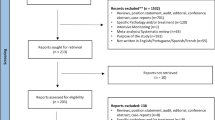Abstract
Purpose
Underreporting is a major limitation of spontaneous reporting systems for suspected adverse drug reactions (ADRs). Several interventions to increase the ADR reporting rate have been proposed, but their efficacy remains poorly investigated.
Methods
This was a questionnaire study aimed at assessing the knowledge, attitudes, and behavior of general practitioners (GPs) regarding ADR reporting and at evaluating whether a monthly e-mail-based newsletter on drug safety could affect the rate and the quality of the ADR reports submitted by these GPs. Three local health authorities (LHAs) of the Emilia–Romagna region were chosen on the basis of their ADR reporting rate during the period preceding the study: Rimini (high), Ferrara (average), and Piacenza (low reporting rate). All GPs (n = 737) associated with these three LHAs were recruited. The pooled number of ADR reports sent by GPs in the remaining seven LHAs of the region was used as controls. The study covered a period of 3 years and was divided into: (1) identification of the reasons leading to underreporting through a questionnaire (Phase I); (2) the intervention, i.e., sending a newsletter for a 10-month period (Phase II); (3) evaluation of the intervention outcomes during the 10 months following the period in which the newsletter had been received (Phase III).
Results
Among GPs involved, 22.8 % returned the questionnaire. Over 94 % of the respondents considered the spontaneous reporting of suspected ADRs to be part of their professional obligations, but only 6.5 % had submitted at least one report in the previous 6 months. Following the completion of Phase II, the overall number of reports coming from the LHAs subjected to the intervention rose by 49.2 % compared to 2009, while the number of reports coming from the control LHAs increased by 8.8 %. Rimini and Piacenza showed a 200 % increase in the number of ADR reports submitted by GPs, while the number of ADR reported submitted by the control group decreased by 25.5 %. In 2011, the number of overall ADRs reports from the LHAs subjected to the intervention decreased by 6.8 %; this decrease reached 50.0 % of the GPs. Control HLAs showed an overall decline of 4.3 %, while the total number of ADRs from GPs increased by 63.3 %. Ferrara was excluded from the analysis due to confounding factors.
Conclusions
The periodic e-mail update on the safety of drugs represents an effective and inexpensive way to raise the awareness of GPs on the importance of spontaneous ADR reporting. Since the outcome of the intervention seemed to disappear after the intervention was stopped, there appears to be a need to adopt a policy of regular updates and educational strategies for health professionals.


Similar content being viewed by others
References
Li C, Xia J, Deng J, Chen W, Wang S, Jiang J, Chen G (2009) A web-based quantitative signal detection system on adverse drug reaction in China. Eur J Clin Pharmacol 65:729–741
van Puijenbroek E, Diemont W, van Grootheest K (2003) Application of quantitative signal detection in the Dutch spontaneous reporting system for adverse drug reactions. Drug Saf 26:293–301
Alvarez-Requejo A, Carvajal A, Begaud B, Moride Y, Vega T, Arias LH (1998) Under-reporting of adverse drug reactions. Estimate based on a spontaneous reporting scheme and a sentinel system. Eur J Clin Pharmacol 54:483–488
Inman WH (1996) Attitudes to adverse drug reaction reporting. Br J Clin Pharmacol 41:434–435
Herdeiro MT, Figueiras A, Polonia J, Gestal-Otero JJ (2005) Physicians’ attitudes and adverse drug reaction reporting: a case-control study in Portugal. Drug Saf 28:825–833
Hazell L, Shakir SA (2006) Under-reporting of adverse drug reactions: a systematic review. Drug Saf 29:385–396
Backstrom M, Mjorndal T, Dahlqvist R (2004) Under-reporting of serious adverse drug reactions in Sweden. Pharmacoepidemiol Drug Saf 13:483–487
Castel JM, Figueras A, Pedros C, Laporte JR, Capella D (2003) Stimulating adverse drug reaction reporting: effect of a drug safety bulletin and of including yellow cards in prescription pads. Drug Saf 26:1049–1055
Johansson ML, Brunlof G, Edward C, Wallerstedt SM (2009) Effects of e-mails containing ADR information and a current case report on ADR reporting rate and quality of reports. Eur J Clin Pharmacol 65:511–514
Motola D, Vargiu A, Leone R, Conforti A, Moretti U, Vaccheri A, Velo G, Montanaro N (2008) Influence of regulatory measures on the rate of spontaneous adverse drug reaction reporting in Italy. Drug Saf 31:609–616
Cosentino M, Leoni O, Banfi F, Lecchini S, Frigo G (1997) Attitudes to adverse drug reaction reporting by medical practitioners in a Northern Italian district. Pharmacol Res 35:85–88
Bandekar MS, Anwikar SR, Kshirsagar NA (2010) Quality check of spontaneous adverse drug reaction reporting forms of different countries. Pharmacoepidemiol Drug Saf 19:1181–1185
Passier A, ten Napel M, van Grootheest K, van Puijenbroek E (2009) Reporting of adverse drug reactions by general practitioners: a questionnaire-based study in the Netherlands. Drug Saf 32:851–858
Hasford J, Goettler M, Munter KH, Muller-Oerlinghausen B (2002) Physicians’ knowledge and attitudes regarding the spontaneous reporting system for adverse drug reactions. J Clin Epidemiol 55:945–950
Edward C, Himmelmann A, Wallerstedt SM (2007) Influence of an e-mail with a drug information attachment on sales of prescribed drugs: a randomized controlled study. BMC Clin Pharmacol 7:12
Figueiras A, Herdeiro MT, Polonia J, Gestal-Otero JJ (2006) An educational intervention to improve physician reporting of adverse drug reactions: a cluster-randomized controlled trial. JAMA 296:1086–1093
Acknowledgments
The study was supported by institutional funds from the Emilia–Romagna region for the developing of pharmacovigilance. We are very grateful to the Drug Policy Service, Emilia–Romagna Region Health Authority, Bologna, Italy and to the pharmacists and GPs of the participating Local Health Authorities (Ferrara, Piacenza and Rimini) for their invaluable contribution to the research.
Competing interest
None.
Author information
Authors and Affiliations
Corresponding author
Rights and permissions
About this article
Cite this article
Biagi, C., Montanaro, N., Buccellato, E. et al. Underreporting in pharmacovigilance: an intervention for Italian GPs (Emilia–Romagna region). Eur J Clin Pharmacol 69, 237–244 (2013). https://doi.org/10.1007/s00228-012-1321-7
Received:
Accepted:
Published:
Issue Date:
DOI: https://doi.org/10.1007/s00228-012-1321-7




